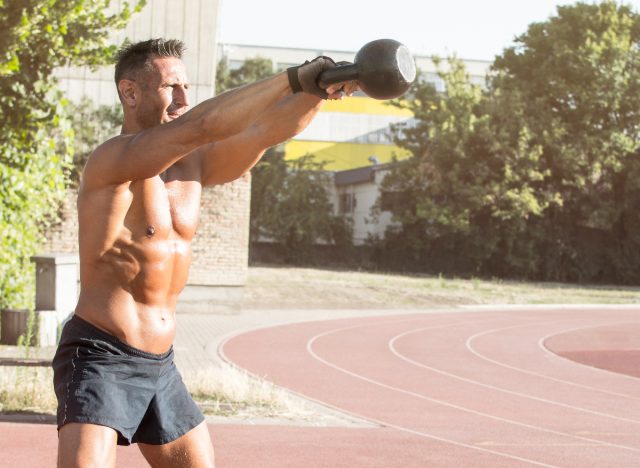
Hugh Jackman is getting his claws out again. As fans know, the Academy Award nominee is reprising his X-Men role as Wolverine in Deadpool 3 and spent months training to take on the famous role for the 10th time. "I've learned you can't rush it. I've learned that it takes time," the 54-year-old told the host of Who's Talking to Chris Wallace? "So, we have six months from when I finish [Broadway's The Music Man] to when I started filming. And I'm not doing any other work. I'm going to be with my family and train. That's going to be my job for six months." Jackman recently showed a sneak peek of what his workouts entail and how he gets his arms so jacked–with a kettlebell. Here's what to know about kettlebell workouts and what experts say about how it can work for you.
How to Get Ripped Arms with a Kettlebell Like Hugh Jackman

Diet and discipline play a major role in Jackman's ripped physique, but so do consistent workouts, which he shares from time to time on social media. In an Instagram post, Jackman holds up a kettlebell showing off his sculpted arms with the caption, "Back. Before the beard. #becomingwolverineagain." According to ACE-certified trainer and nutritionist Mary Sabat MS, RDN, LD, "Kettlebell workouts can be effective for toning your arms and providing overall body conditioning. They engage multiple muscle groups because kettlebell exercises typically involve dynamic movements that engage various muscle groups simultaneously. This engagement includes the muscles in your arms, such as the biceps, triceps, and forearms, as well as the shoulders, chest, back, and core. The combined effort required to stabilize and control the kettlebell throughout the exercises helps to tone and strengthen your arms."
Why Kettlebell Workouts are Effective

Kettlebells require patience in the beginning, but with proper form and technique, they can deliver results. Sabat explains that using a kettlebell during workouts is an effective way to tone and gain strength. They:
- "Promote functional strength: Kettlebell workouts focus on functional movements that mimic real-life activities, such as lifting, swinging, and carrying. This approach helps improve your overall strength and coordination, making it easier to perform daily tasks and reducing the risk of injuries.
- Increase muscular endurance: Kettlebell training often involves performing high-repetition exercises, which can enhance muscular endurance. As your arms repeatedly lift and swing the kettlebell, your muscles adapt by becoming more resistant to fatigue, allowing you to perform more repetitions over time and ultimately toning your arms."
The Heart Health Benefits of Kettlebell Workouts

A kettlebell can not only help meet your fitness goals but provides cardiovascular benefits. "Many kettlebell exercises involve dynamic movements and a combination of strength and cardiovascular conditioning," Sabat tells us. "This dual nature of kettlebell workouts can contribute to improved heart health and increased calorie burn, potentially aiding in weight loss and overall fitness."
There's Many Advantages to Using a Kettlebell

In addition to kettlebells providing a great workout and health benefits, there are other reasons to include one in your next workout. Sabat explains, "In addition to the specific benefits mentioned above, kettlebell workouts offer various advantages:
- Versatility: Kettlebells can be used for a wide range of exercises, including swings, snatches, cleans, presses, and more. This versatility allows you to target different muscle groups and create varied workouts to prevent boredom and continually challenge your body.
- Time efficiency: Kettlebell workouts often incorporate full-body movements, which can lead to more efficient workouts by engaging multiple muscle groups simultaneously. This can save time compared to isolation exercises that focus solely on one muscle group.
- Portability: Kettlebells are compact and portable, making them a convenient option for home workouts or when traveling. You can easily bring a kettlebell along and perform effective exercises wherever you have enough space."
Common Mistakes People Make With Kettlebells

While kettlebell workouts can be highly beneficial, it's important to be aware of common mistakes and follow safety guidelines to prevent injuries. According to Sabat, these are the most common mistakes people make when using a kettlebell.
- Improper form: Using incorrect form during kettlebell exercises can lead to strains, sprains, or other injuries. It's crucial to learn proper technique from a qualified instructor or through reputable instructional resources before attempting more advanced movements.
- Overestimating weight: Start with a manageable weight that allows you to maintain good form throughout the exercises. Gradually increase the weight as you become stronger and more comfortable with the movements.
- Neglecting warm-up and cooldown: As with any workout, warming up before a kettlebell session is essential to prepare your muscles and joints. Similarly, cooling down and stretching afterward can aid in muscle recovery and prevent stiffness.
Expert Safety Tips

With any workout, injury is a possibility. Here's how to try to avoid one. To help prevent injury, Sabat recommends the following safety tips:
- "Begin with a proper warm-up that includes dynamic stretching and mobility exercises to prepare your body for the movements.
- Start with lighter weights and focus on mastering the proper form and technique before progressing to heavier loads.
- Engage your core muscles and maintain a stable posture throughout each exercise to minimize the risk of back or other injuries.
- Listen to your body and avoid pushing through pain. If you experience discomfort or sharp pain during an exercise, stop and seek guidance from a fitness professional.
- Incorporate variety into your kettlebell workouts by using different exercises, rep ranges, and training protocols to keep your muscles challenged and prevent plateaus.
- Consider consulting with a qualified fitness professional or personal trainer to design a program tailored to your specific goals and fitness level.
Remember, it's always important to prioritize safety, proper form, and gradual progression when incorporating kettlebell exercises into your fitness routine."









